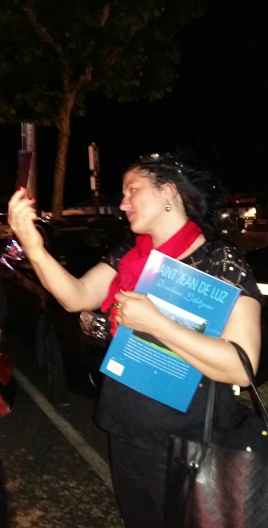 Comprendre les Peurs du Passé pour affronter les Peurs du Présent
Comprendre les Peurs du Passé pour affronter les Peurs du PrésentAction points for Follow up
Suivi dans le cadre du Contrôle Qualité
WORKSHOP 1
atelier 1
SAINT-JEAN-DE-LUZ
an international strategic partnership
INTERNATIONAL COORDINATION - TEACHERS' FOLDER
COORDINATION * TRAVELS * FOLLOW UP * REWRITE
click on the moon to go to the main portal (Homepage)
transnational meeting séminaire transnational
The evaluator (an expert from the French National Agency) thinks our project is so complicated - it is said ambitious - that we need to ensure a big Quality Control to manage it. He did ask to the French coordinator to organize a global survey and did insist on it. So we can think it's one of the thing the Agency will check at the end of our programm (in order to give us the last 20% of the funds)
http://nbeplus.franceserv.eu/eval.html
What are our engagements ?
- The Quality survey system was partly described in the candidacy form (repartition of tasks).
- We did plan in addition to the area skill coordination notes previously planned a foram Check Point made by the international coodinator. It was a result of the first transnational meeting in Roma.
When must we do Check points ?
It is supposed to be done each trimester. But I did make only one for the first six months period (March). The following CP would be done in June, and after that in October.
What sort of methodology
are we supposed to apply ?
Let's see the right column.
by the way of this sort of table.
Recall : R1 agenda
1 Presentation and analysis of the disemination activity
2 Etablishing responsabilities and deadlines
3 Etablishing the schedule of future meetings and general rules about how to organize mobilities
4 Intercultural meetings with teachers form the host school
5 Discussion about the use of non formal methods
6 Dual teaching
- Check point 1 and results (Google Form)
- A question to answer concretely : what can we do to success to fill the gap between timetable and the real achievment of our follow up process ?
Let's go to the blog !
Exercises
Goal : Obtain from the 5 area coordinators the productions and the insertion on our common blog of two coordinations notes (or more than two) for a description of all the productions during Survey Periods 1 and 2.Goal : Obtain from the 5 area coordinators the productions and the insertion on our common blog of two coordinations notes (or more than two) for a description of all the productions during Survey Periods 1 and 2.Goal : Obtain from the 5 area coordinators the productions and the insertion on our common blog of two coordinations notes (or more than two) for a description of all the productions during Survey Periods 1 and 2.
THE END :
Brain storming about the area coordinator's role and the "feedback" they have to produce.
See Check Points 1 and 2 : FOLLOW UP
JUNE 2016
*
WORKSHOPS' ABSTRACTS
Click on the picture

to come back to the report
et notamment sur les tâches de surveillance et de suivi assignées aux coordinateurs des domaines d'étude. Précisions sur leur rôle : qui consiste à collecter l'information auprès des pilotes locaux pour éditer durant chaque phase de supervision une ou plusieurs liste(s) actualisée(s) des actions terminées ou en cours dans chacun des établissements et s'incrivant dans leur champ de compétence. Ils demandent des renseignements ou publient des informations par le biais de notes officielles rédigées en Anglais (ou bilingues) qui s'inspirent dans la forme des notes de supervision émises par le coordinateur généra dit international coordinator (A) et sont insérées dans le blog. Il ne s'agit pas de rédiger une synthèse des travaux faits localement ni de spécialiser chacun des établissements dans un domaine propre mais de rendre compte, tout au contraire, de ce que fait l'ensemble des participants. Vivienne collecte les informations sur les productions littéraires (B) et Alessandra sur les études et activités artistiques (C) tandis que Sanita coordonne les actions de rationalisation et les explications scientifiques (D) et Eda la médiatisation ou "dissemination" (F). Ramona rend compte des études économiques mais a aussi en charge l'autoévaluation du projet et le traitement statistique des questionnaires distribués aux élèves (E). L'ensemble des notes de coordination constitue le journal officiel du partenariat et assure son rétrocontrôle dans la mesure où les coordinateurs peuvent émettre des recommandations, suggérer des pistes de travail..
NB Dans le projet initial (formulaire de candidature) la distribution des coordinateurs reflétait celle des rédacteurs du website commun, au sens où il était prévu que chacun assure la mise en ligne des productions de son domaine de compétence propre (dans une rubrique spécifique du site commun). Mais il est apparu plus simple que les porteurs de projets téléchargent les productions locales directement. Le management du site permettra une mise en page et/ou un rangement a posteriori.
|
Action/decision |
Who |
Deadline |
Results |
|
[1st issue at the meeting’s agenda]
|
|
||
|
|
|
|
|
|
[2d issue at the meeting’s agenda]
|
|
||
|
|
|
|
|
|
[3d issue at the meeting’s agenda]
|
|
||
|
|
|
|
|
Rappel /
Voir la répartition des tâches entre coordinateurs
en cliquant sur l'image :






